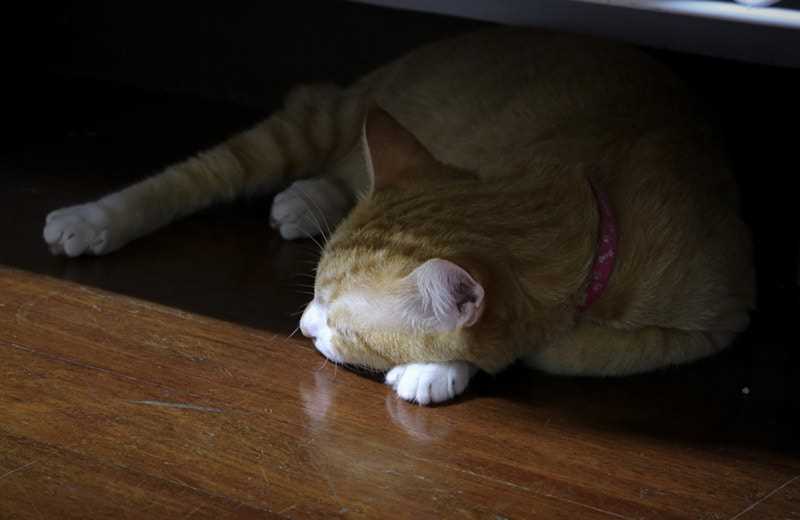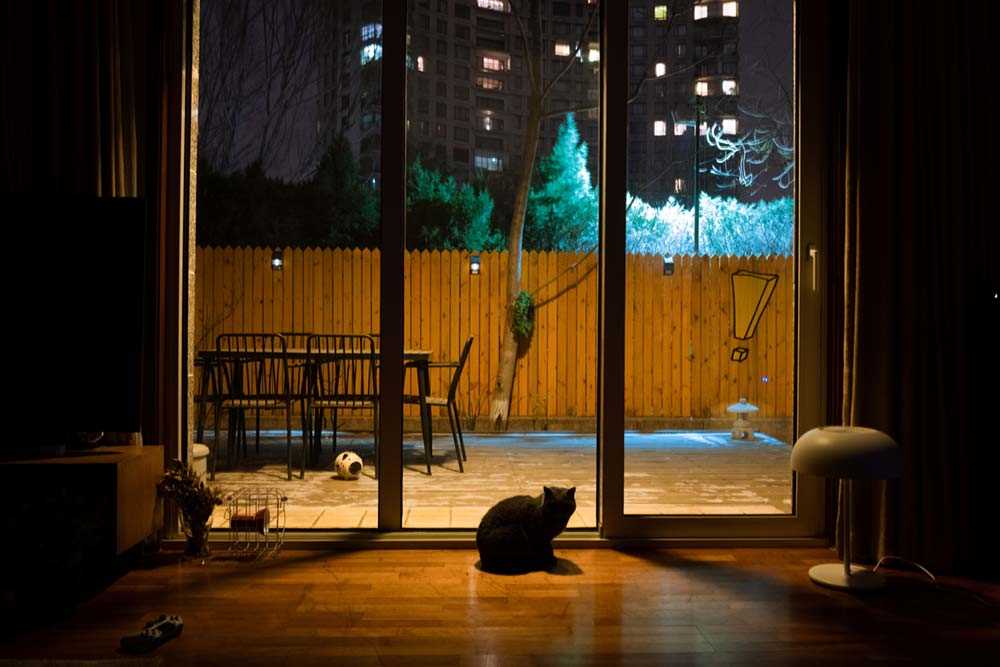



As a Scottish Fold with a keen interest in my own comfort, I’ve discovered that many of my furry friends often choose to settle down in quiet, shadowy spaces. While I can’t speak for every whiskered companion, the majority seem to find solace where the light dims. This preference for low illumination likely stems from our natural instincts; a more subdued environment provides a sense of safety and tranquility.
Observations suggest that the presence of bright lights can disrupt the restful state we seek. In areas illuminated by harsh brightness, I notice increased restlessness among my peers. For those looking to create a cozy sanctuary for their own companions, consider dimming the lights during evening hours, allowing for a calmer atmosphere that encourages relaxation.
Furthermore, while it’s not uncommon for some to enjoy a little light while dozing, the overall trend leans toward a preference for shadowy corners. Ensuring a comfortable, dark nook can significantly enhance the quality of rest for your furry companion, leading to happier and more playful moments during waking hours.
Do Cats Prefer to Sleep in the Dark?

Yes, I enjoy resting in low-light environments. My eyes are adapted for seeing well in dim conditions, allowing me to feel secure while dozing. A calm, shadowy space helps create a cozy atmosphere, making it easier for me to unwind.
Creating a restful area for me can involve using blackout curtains or placing my bed in a corner away from bright lights. Soft bedding also adds to my comfort, which enhances my ability to relax. If you notice I’m more active during twilight hours, it’s a natural instinct inherited from my ancestors who thrived in similar lighting.
Providing multiple spots with varied lighting can be beneficial too. I might alternate between lounging in softer light and darker nooks based on my mood. Each environment offers a unique experience, so consider what makes me happiest when arranging my spaces.
Quietness is equally significant. A tranquil setting devoid of loud noises complements the low-light preference. I appreciate a serene atmosphere that allows me to recharge my energy without disturbances.
In summary, while I enjoy resting in muted light, having options gives me the freedom to choose where I feel most comfortable at any given moment. Tailoring my surroundings to fit these needs ensures I’m content and well-rested.
Understanding Cats’ Natural Sleeping Habits
It’s essential to acknowledge that I, as a feline, thrive on a schedule driven by instinct. My resting patterns are influenced by my ancestors, who were primarily nocturnal hunters. This means I often enjoy periods of quietude during daylight hours, conserving energy for active times when it’s cooler and darker outside.
In my experience, I find comfort in cozy, enclosed spaces that provide security. Choosing a spot for a nap often involves seeking out areas that feel safe and sheltered, whether that’s under a bed or on a sunny windowsill. I also tend to gravitate toward places that offer warmth, especially during cooler months.
Understanding the importance of routine is crucial. Establishing a consistent environment where I can retreat for rest plays a significant role in my well-being. To maintain a healthy lifestyle, it’s wise to ensure I have a designated quiet area, away from disturbances and bright lights, so I can recharge effectively.
If you’re considering dietary aspects related to my health, you might find this link useful: can cats eat before being neutered. Nutrition impacts my energy levels and, consequently, my resting habits.
Creating the Ideal Sleeping Environment for Your Feline Friend

For a cozy spot, choose a quiet area away from foot traffic. A corner or a secluded nook works wonders, allowing for uninterrupted rest. Consider a soft bed or a blanket that retains warmth, providing a sense of security.
Temperature and Comfort

Maintain a comfortable temperature in the room. A cooler environment is preferable, but avoid drafts. A heated pad can be a delightful addition during colder months. Ensure that bedding is clean and free from allergens, contributing to a restful atmosphere.
Lighting and Ambience
While darker spaces can be soothing, some may enjoy a dimly lit area with soft, warm light. Avoid bright or harsh lighting, as it can disrupt tranquility. Natural elements like plants can enhance the ambiance, creating a sense of calm. For outdoor adventures, ensure safety by checking this link on how to keep cats safe outside.
As a Scottish Fold with a keen interest in my own comfort, I’ve discovered that many of my furry friends often choose to settle down in quiet, shadowy spaces. While I can’t speak for every whiskered companion, the majority seem to find solace where the light dims. This preference for low illumination likely stems from our natural instincts; a more subdued environment provides a sense of safety and tranquility.
Observations suggest that the presence of bright lights can disrupt the restful state we seek. In areas illuminated by harsh brightness, I notice increased restlessness among my peers. For those looking to create a cozy sanctuary for their own companions, consider dimming the lights during evening hours, allowing for a calmer atmosphere that encourages relaxation.
Furthermore, while it’s not uncommon for some to enjoy a little light while dozing, the overall trend leans toward a preference for shadowy corners. Ensuring a comfortable, dark nook can significantly enhance the quality of rest for your furry companion, leading to happier and more playful moments during waking hours.
Do Cats Prefer to Sleep in the Dark?

Yes, I enjoy resting in low-light environments. My eyes are adapted for seeing well in dim conditions, allowing me to feel secure while dozing. A calm, shadowy space helps create a cozy atmosphere, making it easier for me to unwind.
Creating a restful area for me can involve using blackout curtains or placing my bed in a corner away from bright lights. Soft bedding also adds to my comfort, which enhances my ability to relax. If you notice I’m more active during twilight hours, it’s a natural instinct inherited from my ancestors who thrived in similar lighting.
Providing multiple spots with varied lighting can be beneficial too. I might alternate between lounging in softer light and darker nooks based on my mood. Each environment offers a unique experience, so consider what makes me happiest when arranging my spaces.
Quietness is equally significant. A tranquil setting devoid of loud noises complements the low-light preference. I appreciate a serene atmosphere that allows me to recharge my energy without disturbances.
In summary, while I enjoy resting in muted light, having options gives me the freedom to choose where I feel most comfortable at any given moment. Tailoring my surroundings to fit these needs ensures I’m content and well-rested.
Understanding Cats’ Natural Sleeping Habits
It’s essential to acknowledge that I, as a feline, thrive on a schedule driven by instinct. My resting patterns are influenced by my ancestors, who were primarily nocturnal hunters. This means I often enjoy periods of quietude during daylight hours, conserving energy for active times when it’s cooler and darker outside.
In my experience, I find comfort in cozy, enclosed spaces that provide security. Choosing a spot for a nap often involves seeking out areas that feel safe and sheltered, whether that’s under a bed or on a sunny windowsill. I also tend to gravitate toward places that offer warmth, especially during cooler months.
Understanding the importance of routine is crucial. Establishing a consistent environment where I can retreat for rest plays a significant role in my well-being. To maintain a healthy lifestyle, it’s wise to ensure I have a designated quiet area, away from disturbances and bright lights, so I can recharge effectively.
If you’re considering dietary aspects related to my health, you might find this link useful: can cats eat before being neutered. Nutrition impacts my energy levels and, consequently, my resting habits.
Creating the Ideal Sleeping Environment for Your Feline Friend

For a cozy spot, choose a quiet area away from foot traffic. A corner or a secluded nook works wonders, allowing for uninterrupted rest. Consider a soft bed or a blanket that retains warmth, providing a sense of security.
Temperature and Comfort

Maintain a comfortable temperature in the room. A cooler environment is preferable, but avoid drafts. A heated pad can be a delightful addition during colder months. Ensure that bedding is clean and free from allergens, contributing to a restful atmosphere.
Lighting and Ambience
While darker spaces can be soothing, some may enjoy a dimly lit area with soft, warm light. Avoid bright or harsh lighting, as it can disrupt tranquility. Natural elements like plants can enhance the ambiance, creating a sense of calm. For outdoor adventures, ensure safety by checking this link on how to keep cats safe outside.
As a Scottish Fold with a keen interest in my own comfort, I’ve discovered that many of my furry friends often choose to settle down in quiet, shadowy spaces. While I can’t speak for every whiskered companion, the majority seem to find solace where the light dims. This preference for low illumination likely stems from our natural instincts; a more subdued environment provides a sense of safety and tranquility.
Observations suggest that the presence of bright lights can disrupt the restful state we seek. In areas illuminated by harsh brightness, I notice increased restlessness among my peers. For those looking to create a cozy sanctuary for their own companions, consider dimming the lights during evening hours, allowing for a calmer atmosphere that encourages relaxation.
Furthermore, while it’s not uncommon for some to enjoy a little light while dozing, the overall trend leans toward a preference for shadowy corners. Ensuring a comfortable, dark nook can significantly enhance the quality of rest for your furry companion, leading to happier and more playful moments during waking hours.
Do Cats Prefer to Sleep in the Dark?

Yes, I enjoy resting in low-light environments. My eyes are adapted for seeing well in dim conditions, allowing me to feel secure while dozing. A calm, shadowy space helps create a cozy atmosphere, making it easier for me to unwind.
Creating a restful area for me can involve using blackout curtains or placing my bed in a corner away from bright lights. Soft bedding also adds to my comfort, which enhances my ability to relax. If you notice I’m more active during twilight hours, it’s a natural instinct inherited from my ancestors who thrived in similar lighting.
Providing multiple spots with varied lighting can be beneficial too. I might alternate between lounging in softer light and darker nooks based on my mood. Each environment offers a unique experience, so consider what makes me happiest when arranging my spaces.
Quietness is equally significant. A tranquil setting devoid of loud noises complements the low-light preference. I appreciate a serene atmosphere that allows me to recharge my energy without disturbances.
In summary, while I enjoy resting in muted light, having options gives me the freedom to choose where I feel most comfortable at any given moment. Tailoring my surroundings to fit these needs ensures I’m content and well-rested.
Understanding Cats’ Natural Sleeping Habits
It’s essential to acknowledge that I, as a feline, thrive on a schedule driven by instinct. My resting patterns are influenced by my ancestors, who were primarily nocturnal hunters. This means I often enjoy periods of quietude during daylight hours, conserving energy for active times when it’s cooler and darker outside.
In my experience, I find comfort in cozy, enclosed spaces that provide security. Choosing a spot for a nap often involves seeking out areas that feel safe and sheltered, whether that’s under a bed or on a sunny windowsill. I also tend to gravitate toward places that offer warmth, especially during cooler months.
Understanding the importance of routine is crucial. Establishing a consistent environment where I can retreat for rest plays a significant role in my well-being. To maintain a healthy lifestyle, it’s wise to ensure I have a designated quiet area, away from disturbances and bright lights, so I can recharge effectively.
If you’re considering dietary aspects related to my health, you might find this link useful: can cats eat before being neutered. Nutrition impacts my energy levels and, consequently, my resting habits.
Creating the Ideal Sleeping Environment for Your Feline Friend

For a cozy spot, choose a quiet area away from foot traffic. A corner or a secluded nook works wonders, allowing for uninterrupted rest. Consider a soft bed or a blanket that retains warmth, providing a sense of security.
Temperature and Comfort

Maintain a comfortable temperature in the room. A cooler environment is preferable, but avoid drafts. A heated pad can be a delightful addition during colder months. Ensure that bedding is clean and free from allergens, contributing to a restful atmosphere.
Lighting and Ambience
While darker spaces can be soothing, some may enjoy a dimly lit area with soft, warm light. Avoid bright or harsh lighting, as it can disrupt tranquility. Natural elements like plants can enhance the ambiance, creating a sense of calm. For outdoor adventures, ensure safety by checking this link on how to keep cats safe outside.







